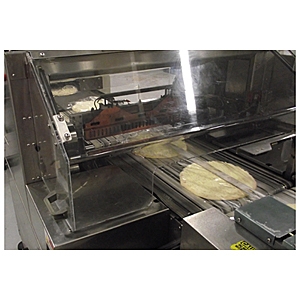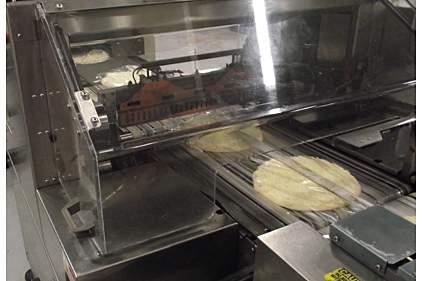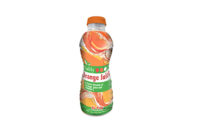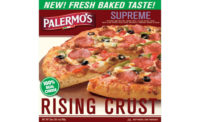Frozen pizza remains one of the most ubiquitous foods in the typical American household. Convenience, low price and a continually growing assortment of options have made frozen pizza a favorite heat-and-serve choice for households constrained by time and budgets.
options have made frozen pizza a favorite heat-and-serve choice for households constrained by time and budgets.
According to the American Frozen Food Institute (AFFI), McLean, Va., 66% of households in the United States consumed frozen pizza in 2010. With total sales reaching $3.2 billion in that year, this accounts for almost 10% of U.S. mass-market frozen food sales. In fact, the United States is the largest frozen pizza market in the world, representing approximately 43% of global market value.
Shrink wrapping challenge
Keeping up with the demand for this very popular consumer product can be a challenge for food processors. Not only because of the high throughputs required, but because frozen pizza can be a difficult product to package. Few frozen food products require more careful handling through the packaging process than pizza. And nowhere in the packaging cycle is this more critical than in shrink wrapping.
Automated shrink wrapping of frozen pizzas has long presented significant challenges for food processors. Delicate handling of these frozen pizza pies is required to keep the sauce and loose toppings like pepperoni, mushrooms, sausage and cheese intact during wrapping. These ingredients tend to shift around and fall to the bottom of the shrink bag before sealing.
Additionally, frozen pizza being a low profile product has a high capability for shingling while traveling back-to-back on the infeed conveyor before entering the wrapper. Shingling prompts poor infeed registration, resulting in missed flights, double product bagging and broken crust. When running at high speeds, such as 100 pizzas per minute, most infeed systems cannot consistently maintain accurate indexing with the shrink wrapper.
The conventional machinery employed for high-speed shrink wrapping of frozen pizzas—at the rate of 100-150 pizzas per minute—typically uses lap seal technology for sealing the shrink bag. The lap seal method wraps the film around the pizza as it goes through a forming shoe, then it overlaps the film on the bottom of the pizza, static sealing it before going into the shrink tunnel. A key problem with this sealing method is that pizza toppings will frequently fall underneath where the seal is being made and compromise the integrity of the seal. When the wrapped pizza comes out of the tunnel, the lap seal can be loose or open, but it is very hard to detect. Usually it is the customer who discovers that the pizza they purchased has not been securely sealed.
To achieve a better quality seal on frozen pizzas, food processors have utilized continuous motion side-seal shrink wrappers. These systems allow a continuous incoming stream of pizzas through the wrapper while a side-seal is generated, followed by an end seal that separates each package before entering the shrink tunnel. Because the seal is being formed on the edge of the pizza rather than across the bottom, the danger of loose toppings contaminating the seal area is eliminated, resulting in a much more reliably sealed package.
Conventional continuous side-seal wrappers, however have a limited speed range. They are useful up to about 100 pizzas per minute throughput—above that and their quality output diminishes. Consequently, many frozen pizza producers have opted for lap seal wrappers to achieve the higher throughput, despite the loss in seal quality.
Palermo’s Pizza’s high-speed, side-seal wrapper line
Now, a new generation of continuous motion side-seal shrink wrapper for frozen pizzas provides the benefits of a secure seal combined with a high-throughput capability. Palermo’s Pizza is one frozen pizza manufacturer that is utilizing this latest continuous side-sealing technology.
Based in Milwaukee, Wis., Palermo’s Pizza was started by Sicilian immigrants Gaspare and Zina Fallucca, who opened an Italian bakery on Milwaukee’s east side in 1964. The bakery expanded into a full-service restaurant known for its pizza, and by 1979, they began to manufacture and sell frozen pizzas based on their family’s traditional Sicilian recipes.
Palermo's is an innovator in the frozen pizza category, creating what is said to be the industry's first self-rising frozen pizza and its first ultra-thin crust product. It manufactures a family of frozen pizzas under the Palermo’s brand, including products such as Primo Thin, Naturally Rising, Stone Baked and Classics by Palermo’s. The company continues to research and develop new products and flavors that cater to consumer needs, such as its recent introduction, Palermo’s Hand Tossed Style, which features “family-favorite flavors” on a middle-thickness crust.
The popularity of these brands has made Palermo’s one of the fastest growing manufacturers of frozen pizzas in the United States. To meet the demand for its products, the company recently expanded its headquarters and manufacturing facility. Opened in 2011, its new 250,000-square-foot state-of-the-art, USDA-certified manufacturing plant is a showpiece of packaging technology, operating four packaging lines for handling its frozen pizzas. But, central to Palermo’s packaging operation is its main packaging line for handling its top-selling 12-inch frozen pizzas.
Prior to reaching that packaging line, sauce and toppings are deposited onto dough to form the pizzas, which are then put through an ammonia-based spiral freezer. Exiting the freezer, the now frozen pizzas are conveyed through the shrink wrapper and shrink tunnel, then on to labeling and cartoning. The product is then cased, palletized and sent off to shipping or deep freeze storage.
“We have been experiencing continued growth at a double-digit rate every year,” says Mike Walz, vice president of operations. “As we grew and the demand for product went up, it generated a need for us to operate at a higher level of speed to meet the demand.”
“The challenge that we were facing as we tried to push our line speeds up was the ability of our existing lap seal wrappers to run at the higher rate of speed and provide a reliable seal,” adds Walz. “The lap sealers use a static sealing process. It is an overlap on the bottom of the pizza. Sometimes, we would lose that seal, and in the shrink tunnel that would open up. That tended to be a limiting factor when running at higher speeds.”
“On our main packaging line, we were using a lap sealer that was operating at less than 90 12-inch pizzas per minute,” says Walz. “So, we embarked on a project to increase the line rate on that line first. After reviewing several shrink wrap designs, we settled on one system that could be custom configured to meet our specific needs instead of adapting to an existing format.”
The system that Palermo’s selected is a high-speed, continuous-motion, servo-controlled side-seal shrink wrapper from Texwrap, a Washington, Mo.-based designer and manufacturer of fully-automatic shrink wrapping systems. What makes this system so unique is its utilization of multiple technologies that are integrated into one system architecture, enabling high-speed throughput of up to 150 frozen pizzas per minute with consistent high-quality seals and without damage to the fragile pizza products.
The throughput speed of the wrapper is achieved by the sealing head, which is a patented servo orbital-motion technology. It eliminates the need for the head to move with the product while the seal is being made. The sealing head moves in an ellipse, without the back and forth motion of typical sealing heads, which dramatically increases the throughput speed of the wrapper.
The orbital head is controlled by fast and precise servo motors, as is the entire wrapper and infeed. The system is built with Generation 3 servo technology, meaning that it was designed from the ground up to integrate servo technology, PLC control and the mechanical elements of the system. The system’s 10-axis servo controls provide extremely accurate registration, minimizing the amount of film used for wrapping and reducing the need for maintenance.
Palermo’s wrapper is equipped with a product protection system, which ensures that the orbital head will not close down on any pizza. A sensor maps the position of each pizza as it enters the orbital head operating space and knows when a pizza is misplaced, skipping that seal cycle.
“We tested the wrapper at 180 pizzas per minute,” Walz says. “This is very fast throughput. But, it performed as expected with accurate registration and secure seals and no product damage. On a continual basis, we normally operate the system at 120-140 pizzas per minute, considerably faster than the maximum 90 pizzas per minute with our prior lap sealer.”
Sealing film securely at such extreme speeds requires a very special side-seal design. The side seal on this system uses the patented Green Machine technology invented by Shrink Packaging Systems Corp., Nashua, N.H. During sealing, belts grip the film securely over a long distance allowing the seal to be made on the pizza and the trim to be cleanly separated. A special heating element seals and separates the film between them. The system is self-compensating. As wrapper speed increases, the film stays in contact with the heating element longer, eliminating the need for constant adjustment. Because the film-gripping belts allow the tension on the film to be isolated from the sealing process, the result is consistent seals using the absolute minimum film width. The other advantage of Green Machine technology is that its simplicity virtually eliminates the maintenance associated with most side-seal designs.
The infeed is optimized as well for maximized throughput and careful product handling. A Texwrap-designed lane-combining system takes three lanes of pizzas exiting the freezer and consolidates them into one lane. Then, a servo-driven flying nose bar is programmed to not only place the pizzas inline at a set spacing without touching each other, but also to automatically adjust the speed of the entire line to match incoming production. This ensures that pizzas do not shingle, keeping toppings and crusts intact, which is critically important at throughput rates of 150 pizzas per minute. Following, a lug conveyor automatically inserts a cardboard circle underneath the pizzas and indexes the product into the wrapper.
The wrapper’s infeed is a totally integrated system that self-adjusts to incoming production. As the pizzas slow down or speed up, so does the entire wrapping system.
To support the shrink wrapper, Palermo’s installed a Texwrap triple-chamber forced air convection tunnel, equipped with digital temperature controls, high velocity fans, individual top and bottom controls for air direction and variable-speed conveyors. These features control the right amount of heat to be put in the right places over the correct amount of time to produce consistent shrink results.
The heat tunnel incorporates a feature called Seams Down, which ensures that the side-seal seams do not position over the printed circular label on top of the pizza. When shrink wrapping pizza, the seam can potentially climb up past the center top of the pizza and obscure the label on the top. By directing the air inside of the tunnel to make the film on the bottom of the pizza shrink before the film on top, this condition is avoided.
Palermo’s entire infeed and shrink wrap system is designed to be sanitary-friendly. Rated for heavy washdown, the corrosion-resistant, welded stainless-steel design eliminates crevices and areas where food could collect. The conveyors incorporate quick-disconnect removable sections for easy cleaning and fall-through design so food debris will not get trapped.
Performance
“Knowing the inherent design of both the static lap seal and the continuous motion side-seal, the speed and the quality of the seal is tremendously improved with the continuous system,” says Walz. “We were able to get a shrink wrap system on our primary line that not only met our design specifications, but exceeded it.”
In the highly competitive frozen pizza market, high volume production with near zero defect rates in packaging is critical to profitability. Those manufacturers that embrace advanced shrink wrapping technology to streamline packaging throughput will be in a better position to run efficient manufacturing plants and reduce operating costs.
For more information, contact Texwrap at 800-886-7421 or go to www.texwrap.com.



